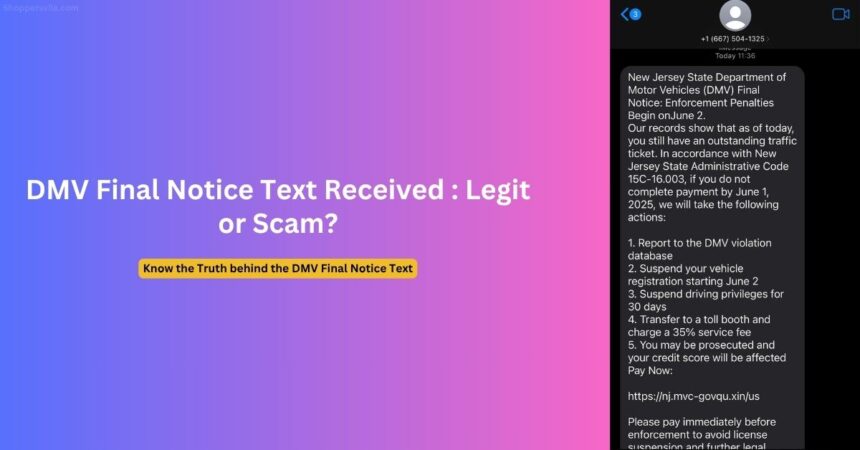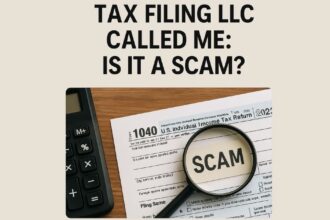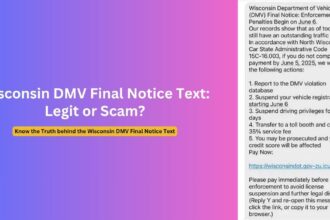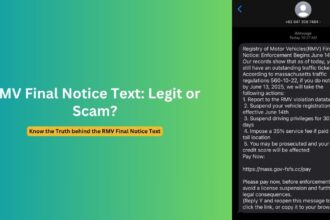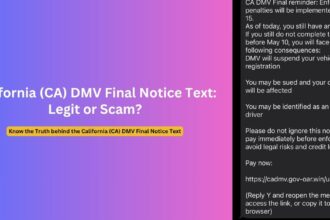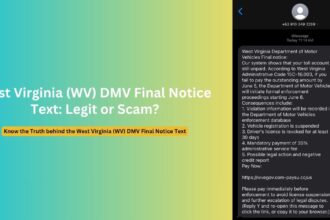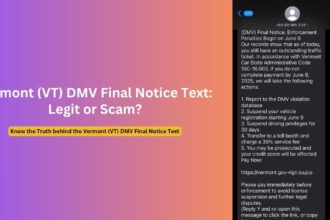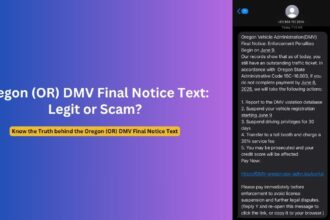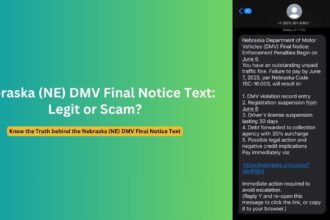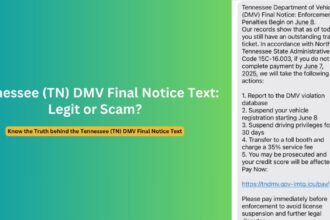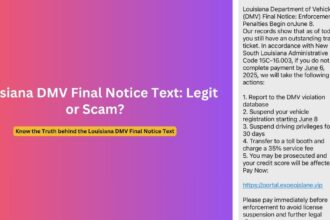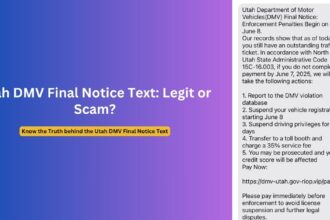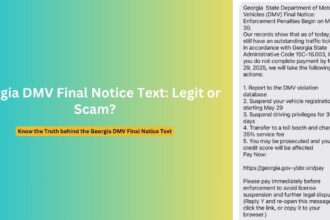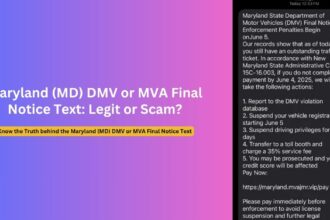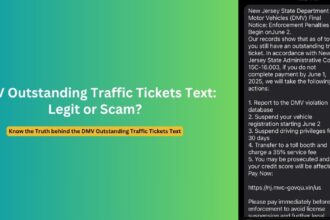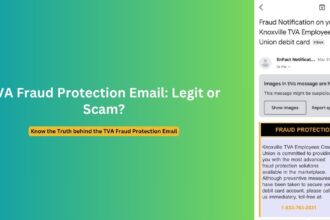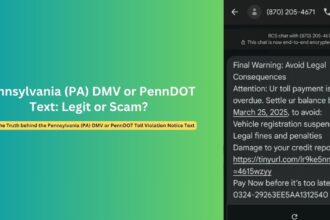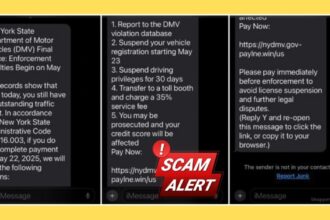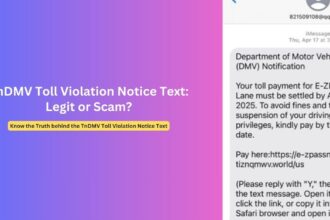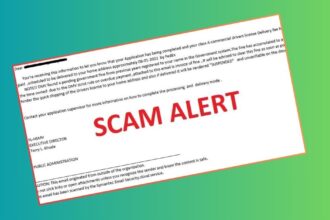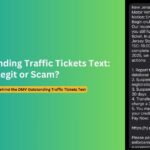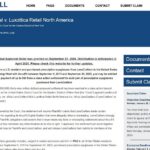A sophisticated nationwide text messaging scam is targeting drivers across all 50 states, with fraudsters impersonating state Departments of Motor Vehicles to steal personal information and money. These “DMV Final Notice” text scams have reached epidemic proportions, affecting millions of Americans through coordinated SMS phishing attacks that threaten immediate legal consequences for fake traffic violations.
Law enforcement agencies from California to Florida, New York to Texas, and everywhere in between have issued urgent warnings as criminals adapt their tactics to target specific states while using identical threat patterns. Understanding this evolving threat and recognizing the warning signs can protect you from becoming another victim of this widespread cybercriminal operation.
Overview of the Nationwide DMV Final Notice Text Scam
The DMV Final Notice text scam represents one of the most widespread cybercriminal operations targeting American drivers in 2025. This sophisticated SMS phishing campaign, known as “SMiShing,” has been reported across all 50 states and territories.
States Affected by the DMV Final Notice Fraud Text Campaign:
The following states have reported significant DMV Final Notice text scam activity, with law enforcement agencies issuing official warnings:
- Alabama – Alabama Department of Public Safety alerts issued
- Alaska – Alaska Division of Motor Vehicles warnings distributed
- Arizona – Arizona Department of Transportation reports filed
- Arkansas – Arkansas Department of Finance and Administration advisories
- California – California DMV official scam alerts widespread
- Colorado – Colorado Division of Motor Vehicles warnings issued
- Connecticut – Connecticut Department of Motor Vehicles alerts
- Delaware – Delaware Division of Motor Vehicles reports
- Florida – Florida DHSMV major scam warnings issued
- Georgia – Georgia Department of Driver Services alerts
- Hawaii – Hawaii Department of Transportation advisories
- Idaho – Idaho Transportation Department warnings
- Illinois – Illinois Secretary of State official alerts issued
- Indiana – Indiana Bureau of Motor Vehicles reports
- Iowa – Iowa Department of Transportation warnings
- Kansas – Kansas Department of Revenue advisories
- Kentucky – Kentucky Transportation Cabinet alerts
- Louisiana – Louisiana Office of Motor Vehicles warnings
- Maine – Maine Bureau of Motor Vehicles reports
- Maryland – Maryland Motor Vehicle Administration alerts
- Massachusetts – Massachusetts Registry of Motor Vehicles warnings
- Michigan – Michigan Secretary of State official advisories
- Minnesota – Minnesota Department of Public Safety alerts
- Mississippi – Mississippi Department of Public Safety warnings
- Missouri – Missouri Department of Revenue reports
- Montana – Montana Motor Vehicle Division alerts
- Nebraska – Nebraska Department of Motor Vehicles warnings
- Nevada – Nevada Department of Motor Vehicles advisories
- New Hampshire – New Hampshire Division of Motor Vehicles alerts
- New Jersey – New Jersey Motor Vehicle Commission major warnings
- New Mexico – New Mexico Motor Vehicle Division reports
- New York – New York State DMV widespread alerts issued
- North Carolina – North Carolina Division of Motor Vehicles warnings
- North Dakota – North Dakota Department of Transportation alerts
- Ohio – Ohio Bureau of Motor Vehicles official advisories
- Oklahoma – Oklahoma Department of Public Safety warnings
- Oregon – Oregon Driver and Motor Vehicle Services alerts
- Pennsylvania – Pennsylvania Department of Transportation major warnings
- Rhode Island – Rhode Island Division of Motor Vehicles reports
- South Carolina – South Carolina Department of Motor Vehicles alerts
- South Dakota – South Dakota Department of Public Safety warnings
- Tennessee – Tennessee Department of Safety advisories
- Texas – Texas Department of Public Safety widespread alerts
- Utah – Utah Division of Motor Vehicles warnings
- Vermont – Vermont Department of Motor Vehicles reports
- Virginia – Virginia Department of Motor Vehicles major alerts
- Washington – Washington Department of Licensing warnings
- West Virginia – West Virginia Division of Motor Vehicles advisories
- Wisconsin – Wisconsin Department of Transportation alerts
- Wyoming – Wyoming Department of Transportation warnings
Scale of the Crisis:
- Reports from all 50 states and Washington D.C.
- Thousands of Americans targeted with customized state-specific messages
- Coordinated international cybercriminal operation
- Financial losses estimated in the tens of millions
- Ongoing FBI and state law enforcement investigations
The scam’s effectiveness stems from its psychological manipulation tactics, exploiting people’s natural anxiety about government enforcement actions. By threatening immediate consequences like license suspension, vehicle registration cancellation, and legal prosecution, scammers hope to bypass victims’ critical thinking and prompt hasty, unwise decisions.
Criminal Evolution: What makes this scam particularly dangerous is its adaptive nature. Criminals customize messages for each state, referencing local agencies and using region-specific terminology to appear more legitimate. However, the underlying structure, threats, and fraudulent domains remain consistent across all variations.
How the Scam Works
Understanding the scammers’ methodology reveals the sophisticated nature of this criminal enterprise and helps potential victims recognize the deceptive tactics being employed.
Stage 1: Data Acquisition and Target Selection
Cybercriminals obtain phone numbers through multiple sources:
- Massive data breaches from retailers, healthcare providers, and financial institutions
- Purchase of contact databases from illegal data brokers
- Social media harvesting and web scraping operations
- Previous scam victim lists sold on dark web marketplaces
- Leaked government databases and voter registration files
Stage 2: State-Specific Message Customization
The criminal operation demonstrates remarkable organization in customizing messages for each state:
- Geographic Targeting: Messages reference specific state DMVs (California DMV, Texas DPS, Florida DHSMV, etc.)
- Local Code References: Use of fake administrative codes that sound region-appropriate
- Timing Coordination: Mass distribution during business hours for maximum impact
- Volume Scaling: Thousands of messages sent simultaneously per state
Stage 3: Psychological Pressure Tactics
The scam employs multiple psychological triggers designed to overwhelm rational thinking:
- Authority Deception: Impersonating government agencies with official-sounding language
- Urgency Manufacturing: Creating artificial deadlines (usually 24-48 hours)
- Consequence Escalation: Threatening progressively severe penalties
- Social Proof: Implying widespread enforcement actions
Stage 4: Technical Deception
Scammers use sophisticated technical methods to appear legitimate:
- Domain Spoofing: Creating URLs that closely mimic official government websites
- International Routing: Using overseas telecommunications to avoid detection
- Link Obfuscation: Requiring manual copying to bypass automated security filters
- Mobile Optimization: Ensuring fraudulent websites work perfectly on smartphones
Stage 5: Information Harvesting and Financial Exploitation
Once victims access fraudulent websites, criminals collect:
- Personal identification information (Social Security numbers, addresses)
- Financial details (credit card numbers, bank account information)
- Government-issued ID data (driver’s license numbers, passport information)
- Security credentials (passwords, PINs, security questions)
Fake DMV Final Notice Text Message Patterns & State-Specific Examples
Universal Template Structure
The DMV Final Notice text scam follows a consistent pattern across all states, with only location-specific customizations:
[STATE NAME] State Department of Motor Vehicles (DMV) Final Notice:
Enforcement Penalties Begin on[DATE].
Our records show that as of today, you still have an outstanding
traffic ticket. In accordance with [STATE] State Administrative
Code [FAKE CODE], if you do not complete payment by [DATE], we
will take the following actions:
1. Report to the DMV violation database
2. Suspend your vehicle registration starting [DATE]
3. Suspend driving privileges for 30 days
4. Transfer to a toll booth and charge a 35% service fee
5. You may be prosecuted and your credit score will be affected
Pay Now: [MALICIOUS URL]
Please pay immediately before enforcement to avoid license
suspension and further legal disputes.
(Reply Y and re-open this message to click the link, or copy
it to your browser.)
State-Specific Variations Documented
California Example: “California State Department of Motor Vehicles (DMV) Final Notice: Enforcement Penalties Begin onJune 2. Our records show outstanding violations under California Vehicle Code 15C-16.003…”
Texas Variation: “Texas Department of Public Safety (DPS) Final Notice: Your vehicle registration will be suspended under Texas Transportation Code 15C-16.003…”
Florida Version: “Florida Department of Highway Safety and Motor Vehicles (DHSMV) Final Notice: Immediate action required under Florida Statute 15C-16.003…”
New York Example: “New York State Department of Motor Vehicles (DMV) Final Notice: License suspension pending under New York Vehicle and Traffic Law 15C-16.003…”
Fraudulent URL Patterns by State
| State | Fake Domain Examples |
|---|---|
| California | california.gov-dmv.xin, ca-dmv.govpay.win |
| Texas | texas.gov-dps.xin, tx-dmv.payment-gov.cc |
| Florida | florida.gov-dhsmv.xin, fl-dmv.govpaid.win |
| New York | newyork.gov-dmv.xin, ny-dmv.payment.cc |
| Pennsylvania | pennsylvania.gov-dmv.xin, pa-dmv.govpay.win |
| Illinois | illinois.gov-dmv.xin, il-dmv.payment-gov.cc |
Critical Red Flags Across All States
Universal Warning Signs
Regardless of which state the scam claims to represent, certain red flags remain consistent across all variations of the DMV Final Notice text scam.
Communication Method Red Flags
| Warning Sign | Why It’s Suspicious |
|---|---|
| Text Message Delivery | No state DMV sends enforcement notices via SMS |
| International Phone Numbers | Government agencies don’t text from +63, +86, or other foreign codes |
| Group Text Inclusion | Official notices are never sent to multiple recipients simultaneously |
| Email-to-SMS Gateway | Messages from email addresses rather than phone numbers |
Content Analysis Red Flags
Language and Grammar Issues:
- Consistent typo: “onJune” instead of “on June” across all state versions
- Improper spacing and formatting inconsistencies
- Non-standard government communication language
- Threatening tone inappropriate for official correspondence
Technical Impossibilities:
- “Transfer to toll booth and charge 35% service fee” – nonsensical in all states
- Fake administrative codes (15C-16.003 is actually from Florida but used for all states)
- Credit score threats (traffic violations don’t directly affect credit in any state)
- Immediate enforcement without due process
State-Specific Knowledge Gaps
Agency Name Errors:
- Using “DMV” for states that use different agency names
- Texas actually uses “Department of Public Safety” (DPS)
- Florida uses “Department of Highway Safety and Motor Vehicles” (DHSMV)
- Some states have “Motor Vehicle Commission” or “Motor Vehicle Division”
Legal Code Misrepresentations:
- Using identical fake codes across different state legal systems
- Referencing non-existent administrative sections
- Mixing federal and state code references inappropriately
How to Identify and Protect Yourself from Fraudulent DMV Final Notice Texts
Immediate Recognition Strategies
Quick Verification Checklist:
- Source Verification: Did you receive any prior mail notices?
- Agency Confirmation: Does the sender use your state’s correct agency name?
- Communication Method: Do you have texting enabled with your state DMV?
- URL Analysis: Does the link use your state’s official .gov domain?
- Timing Logic: Are you actually expecting any DMV correspondence?
State-by-State Verification Resources
Official State DMV Websites for Verification:
- California: dmv.ca.gov
- Texas: dps.texas.gov
- Florida: flhsmv.gov
- New York: dmv.ny.gov
- Pennsylvania: dmv.pa.gov
- Illinois: ilsos.gov
- Ohio: bmv.ohio.gov
- Georgia: dds.georgia.gov
- North Carolina: ncdot.gov/dmv
- Michigan: michigan.gov/sos
Comprehensive Protection Protocol
Immediate Response Actions:
- DO NOT click any links in suspicious DMV texts
- DO NOT reply to the message in any format
- DO NOT call phone numbers provided in the text
- DO take screenshots for documentation purposes
- DO delete the message after documenting
- DO report to 7726 (SPAM) and appropriate authorities
Verification Process:
- Independent Research: Visit your state’s official DMV website directly
- Phone Verification: Call your state DMV using published contact numbers
- Mail Review: Check for any official postal correspondence
- Account Access: Log into official DMV portals through verified channels
Long-Term Protection Strategies
Device and Account Security:
- Enable advanced spam filtering on smartphones
- Install reputable mobile security applications
- Keep operating systems and apps updated
- Use multi-factor authentication on government accounts
- Regularly review and update privacy settings
Personal Information Management:
- Limit sharing phone numbers with non-essential services
- Monitor credit reports quarterly for suspicious activity
- Use unique, strong passwords for government portals
- Be cautious about social media information sharing
What to Do if You’ve Encountered the Scam
If You Received the Text But Didn’t Interact
Immediate Actions:
- Document the incident with screenshots showing sender information
- Report to federal authorities:
- Federal Trade Commission: reportfraud.ftc.gov
- FBI Internet Crime Complaint Center: ic3.gov
- Report to state authorities:
- Your state’s Attorney General office
- Local law enforcement if financial loss occurred
- Alert your network about the scam without forwarding original messages
If You Clicked the Link But Entered No Information
Security Response Protocol:
- Immediately disconnect from internet connectivity
- Run comprehensive malware scans using updated security software
- Clear all browser data including cache, cookies, and stored passwords
- Update all software including operating system and security applications
- Monitor all accounts for unusual activity over the following weeks
If You Provided Personal Information
Emergency Response Checklist:
- Financial Institution Contact: Immediately notify banks and credit card companies
- Credit Protection: Place fraud alerts with all three credit bureaus (Experian, Equifax, TransUnion)
- Password Security: Change passwords on all important accounts, especially financial and government portals
- Government Notification: Contact your state DMV to report the impersonation
- Documentation: Create detailed records of all information potentially compromised
Ongoing Monitoring Requirements:
- Review all financial statements for unauthorized transactions
- Monitor credit reports for new accounts or inquiries
- Watch for signs of identity theft including unexpected bills or correspondence
- Consider identity monitoring services for extended protection
If You Made a Payment
Critical Emergency Actions:
- Bank Contact: Immediately call your bank’s fraud hotline
- Transaction Dispute: File formal disputes for all unauthorized charges
- Card Replacement: Request immediate replacement of compromised payment cards
- Account Monitoring: Enable enhanced monitoring on all financial accounts
Legal and Reporting Requirements:
- Police Report: File reports with local and state law enforcement
- Federal Reporting: Submit complaints to FBI Internet Crime Complaint Center
- Consumer Protection: Report to your state’s consumer protection agency
- Recovery Assistance: Contact bank fraud departments for recovery procedures
Official State Agency Responses and Policies
Coordinated Law Enforcement Response
Federal Level Coordination:
- FBI Cyber Division leading multi-state investigation
- Federal Trade Commission tracking consumer complaints nationwide
- Department of Homeland Security monitoring international cybercrime connections
- U.S. Postal Inspection Service investigating mail fraud connections
State-Level Responses:
- All 50 state DMV agencies have issued public warnings
- State Attorneys General coordinating prosecution efforts
- Local law enforcement training on cybercrime response
- Public awareness campaigns across multiple states
Universal State DMV Policies
Consistent Communication Policies Across All States:
- Text Messages: No state DMV sends enforcement notices via SMS
- Email Communications: Limited to appointment confirmations and voluntary subscriptions
- Official Notices: All enforcement actions communicated through postal mail
- Payment Methods: Only accepted through official channels with proper verification
Frequently Asked Questions (FAQs)
1. Is the DMV Final Notice text message legitimate?
No, DMV Final Notice text messages are never legitimate. No state Department of Motor Vehicles in the United States sends enforcement notices, payment demands, or violation warnings via text message. All legitimate DMV communications regarding violations, suspensions, or enforcement actions are sent through official postal mail with proper state letterhead and contact information. Any text claiming to be a “DMV Final Notice” is a scam designed to steal your personal information or money.
2. Why do these scam texts reference different states, and how do scammers know which state to target?
Scammers cast wide nets by sending massive volumes of texts with different state customizations to phone numbers across the country. They don’t necessarily know your actual state of residence – they’re using area codes, purchased contact lists, and geographical assumptions to target regions. Many people receive scam texts for states they’ve never lived in. The scammers hope that some percentage of recipients will be from the targeted state and fall for the localized version.
3. What should I do if I clicked the link in a DMV Final Notice scam text?
If you clicked the link but didn’t enter personal information, immediately disconnect from the internet, run comprehensive antivirus scans, clear your browser data, and monitor your accounts closely. If you entered personal or financial information, contact your bank immediately, place fraud alerts on your credit reports, change passwords on important accounts, and file reports with local police and the FBI’s Internet Crime Complaint Center. The sooner you act, the better you can protect yourself from further damage.
4. How can I verify if I actually have outstanding violations with my state DMV?
To check for legitimate violations, visit your state’s official DMV website directly (never through links in text messages), call your state DMV at their published phone number, or visit a DMV office in person. Most states also offer online portals where you can check your driving record and any outstanding issues. Never use links provided in text messages to verify your status, as these lead to fraudulent websites designed to steal your information.
5. Are similar scams targeting other government agencies besides DMVs?
Yes, cybercriminals use similar tactics to impersonate various government agencies including the IRS, Social Security Administration, Medicare, E-ZPass authorities, court systems, and local police departments. The pattern is consistent: urgent text messages or emails threatening immediate consequences unless you take action by clicking a link or calling a number. Remember that legitimate government agencies primarily communicate through official mail and never demand immediate payments or personal information through unsolicited texts or emails.
Conclusion
The DMV Final Notice text scam represents a serious and evolving threat to Americans nationwide, demonstrating how cybercriminals adapt their tactics to exploit people’s trust in government institutions. By understanding the sophisticated nature of these attacks, recognizing the consistent warning signs, and knowing how to respond appropriately, you can protect yourself and your family from these dangerous fraudulent schemes.
The key to staying safe lies in remembering that legitimate government agencies, including all state DMVs, follow established communication protocols and never demand immediate action through text messages. When faced with any communication claiming to be from a government agency, always verify through official channels before taking any action, regardless of how urgent or threatening the message appears.
As cybercriminals continue to evolve their tactics, staying informed about current scam techniques becomes increasingly important. Law enforcement agencies across all 50 states are working diligently to investigate these crimes and prosecute the perpetrators, but individual vigilance remains the most effective defense against these sophisticated threats.
By sharing this knowledge with family, friends, and community members, we can collectively reduce the effectiveness of these criminal operations and protect vulnerable populations from financial harm and identity theft. Remember: when in doubt, verify independently through official channels, and never let urgency override careful verification.
Stay protected from the latest scam alerts and cybersecurity threats with expert guidance from ShoppersVila.com – your comprehensive resource for consumer protection and digital safety in an increasingly connected world.
